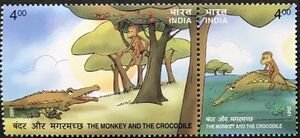The Monkey and the Crocodile Se-tenant Pair

Technical Data
| Stamp Set | Tales from the Panchatantra |
|---|---|
| Date of Issue | October 17, 2001 |
| Denomination | Rs. 8 |
| Quantity | 3,000,000 |
| Perforation | comb 13 |
| Printer | Madras Security Printers |
| Watermark | No Watermark |
| Colors | Multicolor |
| Catalog Codes |
Michel IN 1862-1863 Stamp Number IN 1920 Yvert et Tellier IN 1626-1627 Stanley Gibbons IN 2027a |
| Themes | Animals (Fauna) | Crocodiles | Fairy Tales | Mammals | Monkeys | Reptiles |
The Monkey and the Crocodile Se-tenant Pair
Table of Contents
Commemorative Stamp Set:
- Theme: “The Monkey and the Crocodile,” one of the most well-known stories from the Panchatantra, is depicted through a se-tenant pair of stamps. These stamps are designed as a connected set of two that narrate the story visually, emphasizing the cleverness of the monkey and the folly of the crocodile.
Design Elements:
- Stamp 1 (The Beginning of the Journey): The first stamp in the pair shows the monkey riding on the crocodile’s back as they journey across a river. The monkey looks content and unaware, while the crocodile swims with a hidden agenda. The river and surrounding trees reflect a peaceful but deceptive scene.
- Stamp 2 (The Clever Escape): The second stamp illustrates the moment when the monkey tricks the crocodile into turning back to the riverbank by saying he left his heart on the tree. The monkey is shown jumping off the crocodile’s back onto the safety of the tree, with the crocodile looking surprised and defeated. The background features the riverbank, completing the visual narrative.
Cultural and Historical Significance:
- Moral Wisdom: This pair of stamps beautifully captures the essence of the Panchatantra, where wit and intelligence overcome greed and deceit. It teaches a timeless lesson on how cleverness and quick thinking can help one navigate difficult situations.
- Cultural Icon: The story of the monkey and the crocodile is widely known in Indian folklore and has been passed down through generations. The stamps not only honor this classic fable but also serve as a reminder of the rich tradition of storytelling in Indian culture.
Usage:
- Educational Tool: The se-tenant pair can be used in educational programs to introduce children to Panchatantra stories and their embedded moral lessons. It can also be featured in school curriculum and storytelling workshops.
- Philatelic Collections: The stamps will appeal to philatelists, especially those interested in themes of literature, folklore, and moral education.
- Cultural Events: These stamps could be issued during literature festivals, cultural heritage days, or commemorative events related to ancient Indian classics.
Importance of the Commemorative Stamp Set:
- Promotion of Cultural Heritage: This se-tenant pair serves as a beautiful representation of the ancient Panchatantra, contributing to the preservation and promotion of Indian literature.
- Moral and Educational Value: By depicting this well-known fable, the stamp set emphasizes the importance of wit, presence of mind, and quick thinking—values that are just as relevant today as they were centuries ago.
Example of the Stamp Design:
- Se-tenant Pair: The two stamps are aligned side by side, forming a continuous scene when placed together. The flowing river acts as a connecting element between the two stamps, with one side showing the crocodile’s deceit and the other highlighting the monkey’s clever escape.
- Colors: Rich hues of green and blue dominate the design, representing the natural setting of the forest and river.
- Textures: The monkey is depicted with a lively, expressive face, while the crocodile’s expressions shift from slyness in the first stamp to surprise in the second.
Significance:
- Cultural Legacy: This set not only preserves an ancient story but also promotes the universal value of intelligence over force, making it a relevant educational tool across generations.
